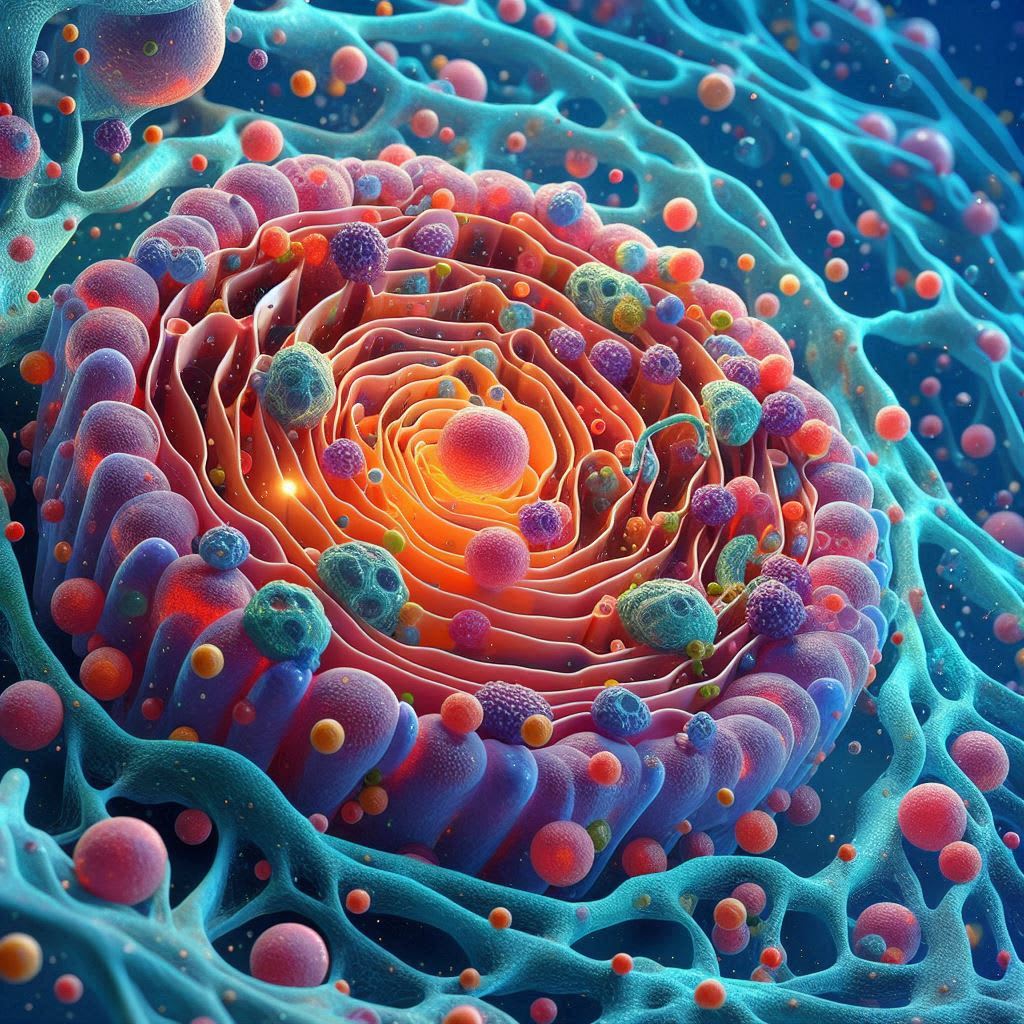The Cell's Secret Factory
Unveiling the Endoplasmic Reticulum

The Hidden Chemists Within: Unveiling Your Body's Microscopic Powerhouses
Imagine a bustling factory tucked away inside every cell of your body, whirring with activity. This isn't science fiction; it's the remarkable reality of the endoplasmic reticulum (ER), a network of membranes that acts as the cell's very own chemical production line. These microscopic marvels are more than just factories – they're the unsung heroes of your internal chemistry, orchestrating the creation of essential molecules that keep you alive and thriving. Let's embark on a fascinating journey to explore the ER, its structure, function, and why it matters to your well-being.
Why Should You Care? The ER's Impact on Your Daily Life
The ER plays a crucial role in virtually every cellular process, impacting your health in surprising ways. Here are some examples of its everyday influence:
Energy Levels: The ER manufactures enzymes used in cellular respiration, the process that converts food into usable energy. Efficient protein folding by the ER ensures these enzymes function optimally, keeping your energy levels stable.
Sharp Thinking: The ER produces essential components of nerve cells, including myelin, a fatty sheath that insulates nerve fibers. Proper ER function is crucial for clear communication between neurons, impacting memory, focus, and cognitive function.
Strong Muscles: In muscle cells, a specialized ER called the sarcoplasmic reticulum stores and releases calcium ions, which trigger muscle contractions. Efficient ER function ensures smooth and coordinated muscle movement, allowing you to perform daily activities with ease.
Detoxification Powerhouse: The ER in liver cells acts as a detox center, containing enzymes that break down and eliminate toxins from medications, environmental pollutants, and even some byproducts of your own metabolism.
Understanding the Structure: A Tale of Two Reticula
Picture a maze of interconnected tubes within the cell. That's the basic structure of the ER. There are two main types, each with specialized functions:
Rough Endoplasmic Reticulum (RER): Aptly named for the ribosomes – tiny protein-making machines – studded on its surface. Here, proteins are synthesized, meticulously folded into their proper shapes, and tagged for their destinations within or outside the cell.
Smooth Endoplasmic Reticulum (SER): Lacks ribosomes and specializes in the production of lipids (fats) and steroids. It also houses enzymes responsible for detoxification and calcium storage in muscle cells.
The Intricate Dance of Protein Production: From Blueprint to Action
Think of the RER as a protein assembly line. Here's a simplified breakdown:
Messenger RNA (mRNA), carrying the instructions for protein assembly, arrives from the nucleus.
Ribosomes attached to the RER translate the mRNA instructions into amino acid sequences, the building blocks of proteins.
Newly formed proteins undergo modifications within the RER, like folding and attaching sugar molecules, to ensure they function properly. Misfolded proteins are flagged for disposal to prevent cellular malfunction.
"Ready" proteins are packaged into transport vesicles and shipped to their final destinations within the cell, or secreted outside the cell for functions like building tissues or enzymes.
The Delicate Balance: When the Hidden Chemists Go Awry
Disruptions in ER function can lead to various health conditions. Here are some examples:
Cystic Fibrosis: A genetic disorder affecting the RER in lung cells, leading to thick, sticky mucus that hinders breathing.
Metabolic Diseases: Mutations in enzymes within the ER can disrupt lipid and carbohydrate metabolism, causing conditions like Niemann-Pick disease and glycogen storage diseases.
Neurodegenerative Diseases: Emerging research suggests abnormalities in ER function may contribute to the development of Alzheimer's disease and Parkinson's disease, possibly due to the accumulation of misfolded proteins.
The Future of ER Research: A Glimpse into New Frontiers
Scientists are actively exploring the ER's role in various diseases. Some promising areas of research include:
Gene Therapy: Correcting faulty genes responsible for ER-related diseases like cystic fibrosis. This approach holds promise for offering a permanent cure rather than managing symptoms.
Drug Development: Identifying drugs that can restore proper protein folding and function in the ER could potentially treat a wide range of diseases caused by protein misfolding.
Understanding Neurodegenerative Diseases: Unraveling the link between ER stress and the development of neurodegenerative conditions could lead to novel therapeutic strategies for these currently incurable diseases.
Personalized Medicine: Understanding an individual's unique genetic makeup and potential ER dysfunction could pave the way for personalized treatments tailored to address specific protein folding abnormalities.
Beyond the Basics: Unveiling the Nuances of the ER
The ER is a dynamic and complex organelle with many fascinating aspects still being discovered. Here are some recent findings that shed light on the ER's intricate workings:
Communication Hub: The ER isn't an isolated factory. It interacts with other cell structures like the Golgi apparatus and mitochondria, ensuring a smooth flow of materials and energy within the cell. This intricate communication network is crucial for efficient cellular function.
Stress Response Mechanism: The ER is surprisingly attuned to cellular stress, such as protein misfolding or nutrient deprivation. When such stress occurs, the ER activates cellular pathways to restore balance. This "unfolded protein response" helps the cell cope with challenges and maintain proper function.
Gut Microbiome Connection: Emerging research suggests gut bacteria may influence ER function through signaling pathways. A healthy gut microbiome may contribute to efficient protein folding and overall cellular health, highlighting the fascinating interconnectedness of our bodies.
Conclusion: The Microscopic Powerhouses Within
The ER, often overshadowed by the nucleus and mitochondria, is a fascinating and vital organelle. By unraveling its intricate workings, scientists are gaining valuable insights into human health and disease. Understanding the ER empowers us to appreciate the complex symphony of life occurring within each of our cells. As research progresses, the hidden chemists within hold the potential for groundbreaking advancements in medicine, personalized treatments, and a deeper understanding of how our bodies function at a cellular level. The future of health may very well lie in unlocking the full potential of these microscopic powerhouses within us.
About the Creator
suren arju
Hi there! I'm Suren, your startup guide. Entrepreneur, writer, dreamer - I share insights, tips & stories to fuel your startup journey. Ready to explore, learn & win together? Join me & let's redefine how we launch, learn & leap!
Enjoyed the story? Support the Creator.
Subscribe for free to receive all their stories in your feed. You could also pledge your support or give them a one-off tip, letting them know you appreciate their work.





Comments
There are no comments for this story
Be the first to respond and start the conversation.